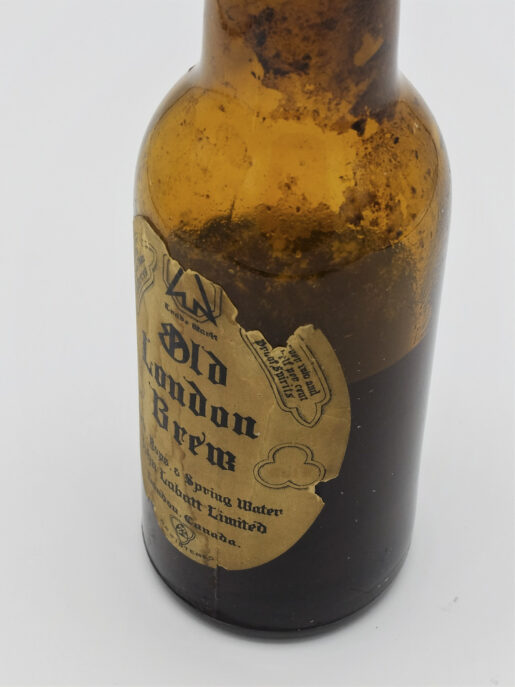
Bottle, “Old London Brew,” 2010.011.1715, 23.3 x 6.8 x 6.8 cm
This is a bottle of Labatt Old London Brew, a Prohibition-era “near beer.” Did you know it can illustrate multiple themes in Canadian history? It is an artifact of First Wave Feminism because so many women gained political skill in the temperance movement. It is a First World War artifact because it was the wartime argument against food waste that wrung prohibition out of the Ontario legislature in 1916 and later the federal government. It is also an artifact of Canadian industry because it tells the story of a brewery begun in London, Ontario in 1847. Now foreign-owned, it’s still there.
Although seemingly prosaic, this artifact is physical evidence of Canadian strength and ingenuity. It took perseverance on the part of the Canadian women and men who never gave up believing that society would be better if alcohol consumption was limited or banned. It also illustrates the resourcefulness of the Labatt brewery. While other breweries closed, Labatt looked for ways to adapt to the new climate. It continued to brew regular strength beer for the export market and it brewed Old London Brew as well as Comet beer for the home market. This kept the brewery going and many Londoners employed.

It’s only slightly tongue in cheek to ask, “What could be more important to Canadian culture and heritage than beer?” After all, Canadians love their beer and are proud of it.
Today, this piece continues to be important to Canadian culture and heritage. It’s only slightly tongue in cheek to ask, “What could be more important to Canadian culture and heritage than beer?” After all, Canadians love their beer and are proud of it. Or is this only something that breweries want us to believe as they link the consumption of beer to Canadian identity and nationalism? Whatever your opinion on this question, it is undeniable that the Labatt brewery has been a major player on the Canadian brewing scene. Over many decades, it has created products enjoyed across Canada and beyond.
And if you want to talk about how this object might be relevant to today, let’s just remember that alcohol was the drug crisis of another time. Banning its consumption through prohibition was believed by many to be the only answer to solving the problem of crime and loss of life. Today, we’re dealing with other drug-related issues. How should marijuana be sold when it is legalized? How can we deal with the different aspects of the opioid crisis? We can look to this bottle to learn what worked in the past and what didn’t work.